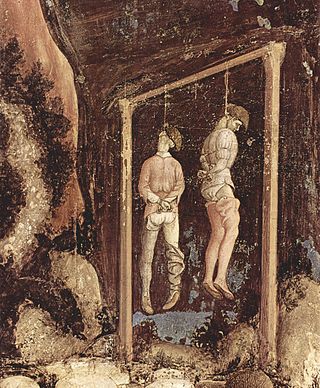
The breaking wheel, also known as the execution wheel, the Wheel of Catherine or the (Saint) Catherine('s) Wheel, was a torture method used for public execution primarily in Europe from antiquity through the Middle Ages up to the 19th century by breaking the bones of a criminal or bludgeoning them to death. The practice was abolished in Bavaria in 1813 and in the Electorate of Hesse in 1836: the last known execution by the "Wheel" took place in Prussia in 1841. In the Holy Roman Empire it was a "mirror punishment" for highwaymen and street thieves, and was set out in the Sachsenspiegel for murder, and arson that resulted in fatalities.

Hanging is killing a person by suspending them from the neck with a noose or ligature. Hanging has been a common method of capital punishment since the Middle Ages, and has been the primary execution method in numerous countries and regions. The first known account of execution by hanging is in Homer's Odyssey. Hanging is also a method of suicide.

Albert Pierrepoint was an English hangman who executed between 435 and 600 people in a 25-year career that ended in 1956. His father Henry and uncle Thomas were official hangmen before him.

A gallows is a frame or elevated beam, typically wooden, from which objects can be suspended or "weighed". Gallows were thus widely used to suspend public weighing scales for large and heavy objects such as sacks of grain or minerals, usually positioned in markets or toll gates. The term was also used for a projecting framework from which a ship's anchor might be raised so it is no longer sitting on the seabed, riverbed or dock; "weighing [the] anchor" meant raising it using this apparatus while avoiding striking the ship's hull.

Bondage in BDSM is the activity of tying or restraining people using equipment such as chains, cuffs, or collars for mutual erotic pleasure. According to the Kinsey Institute, 12% of females and 22% of males respond erotically to BDSM.
Capital punishment in Canada dates to Canada's earliest history, including its period as first a French then a British colony. From 1867 to the elimination of the death penalty for murder on July 26, 1976, 1,481 people had been sentenced to death, and 710 had been executed. Of those executed, 697 were men and 13 women. The only method used in Canada for capital punishment of civilians after the end of the French regime was hanging. The last execution in Canada was the double hanging of Arthur Lucas and Ronald Turpin on December 11, 1962, at Toronto's Don Jail. The National Defence Act prescribed the death penalty for certain military offences until 1999, although no military executions had been carried out since 1946.

A garrote or garrote vil is a weapon and a method of capital punishment. It consists of a handheld ligature of chain, rope, scarf, wire or fishing line, used to strangle a person.

Execution Dock was a site on the River Thames near the shoreline at Wapping, London, that was used for more than 400 years to execute pirates, smugglers and mutineers who had been sentenced to death by Admiralty courts. The "dock" consisted of a scaffold for hanging. Its last executions were in 1830.

The Halifax Gibbet was an early guillotine used in the town of Halifax, West Yorkshire, England. Estimated to have been installed during the 16th century, it was used as an alternative to beheading by axe or sword. Halifax was once part of the Manor of Wakefield, where ancient custom and law gave the Lord of the Manor the authority to execute summarily by decapitation any thief caught with stolen goods to the value of 131⁄2d or more, or who confessed to having stolen goods of at least that value. Decapitation was a fairly common method of execution in England, but Halifax was unusual in two respects: it employed a guillotine-like machine that appears to have been unique in the country, and it continued to decapitate petty criminals until the mid-17th century.

John Clarence Woods was a United States Army master sergeant who, with Joseph Malta, carried out the Nuremberg executions of ten former top leaders of the Third Reich on October 16, 1946, after they were sentenced to death at the Nuremberg trials. Time magazine credited him with 347 executions to that date during a 15-year career. According to later research, a number of 60 to 70 over a period of two years is more credible.

William Calcraft was a 19th-century English hangman, one of the most prolific of British executioners. It is estimated in his 45-year career he carried out 450 executions. A cobbler by trade, Calcraft was initially recruited to flog juvenile offenders held in Newgate Prison. While selling meat pies on streets around the prison, Calcraft met the City of London's hangman, John Foxton.

To be hanged, drawn and quartered was a method of torturous capital punishment used principally to execute men convicted of high treason in medieval and early modern Britain and Ireland. The convicted traitor was fastened to a hurdle, or wooden panel, and drawn behind a horse to the place of execution, where he was then hanged, emasculated, disembowelled, beheaded, and quartered. His remains would then often be displayed in prominent places across the country, such as London Bridge, to serve as a warning of the fate of traitors. The punishment was only ever applied to men; for reasons of public decency, women convicted of high treason were instead burned at the stake.
John Austin was an English footpad who became the last person to be hanged at the Tyburn gallows just outside London. He was sentenced to death for the attempted murder of a labourer called John Spicer from Kent. The Recorder of London, James Adair, described it as a "robbery with violence" that involved "cutting and wounding [...] in a cruel manner." This hanging would mark the end of Tyburn, a village in Middlesex, being a place of executions for almost 600 years.

The Bisbee massacre occurred in Bisbee, Arizona, on December 8, 1883, when six outlaws who were part of the Cochise County Cowboys robbed a general store. Believing the general store's safe contained a mining payroll of $7,000, they timed the robbery incorrectly and were only able to steal between $800 and $3,000, along with a gold watch and jewelry. During the robbery, members of the gang killed five people, including a lawman and a pregnant woman. Six men were convicted of the robbery and murders. John Heath, who was accused of organizing the robbery, was tried separately and sentenced to life in prison. The other five men were convicted of murder and sentenced to hang.
The Nuremberg executions took place on October 16, 1946, shortly after the conclusion of the Nuremberg trials. Ten prominent members of the political and military leadership of Nazi Germany were executed by hanging: Hans Frank, Wilhelm Frick, Alfred Jodl, Ernst Kaltenbrunner, Wilhelm Keitel, Joachim von Ribbentrop, Alfred Rosenberg, Fritz Sauckel, Arthur Seyss-Inquart, and Julius Streicher. Hermann Göring was also scheduled to be hanged on that day but committed suicide using a potassium cyanide capsule the night before. Martin Bormann was also sentenced to death in absentia; at the time his whereabouts were unknown, but it has since been confirmed that he died while attempting to escape Berlin on May 2, 1945.

Hannah Dagoe was an Irish basket-woman, sentenced to death for burglary. On the day of her execution, 4 May 1763, in what The Newgate Calendar described as an "extraordinary and unprecedented scene" she struggled violently with the executioner, and with the noose about her neck, flung herself from the cart before the signal was given, dying instantly.

The 1807 Newgate disaster or the Old Bailey Accident of 1807 was a crowd crush that occurred outside London's Newgate Prison on 23 February 1807. The disaster occurred when part of a large, dense crowd that had gathered to witness a triple execution, was destabilised after being disturbed by a collapsing wooden cart, which triggered a chain of events leading to a fatal crowd crush. Many fatalities and severe injuries resulted, with newspapers reporting that at least 27 perished in the accident and one observer counting at least 34 dead.

Alexander Green was an Australian executioner. He arrived in the colony of New South Wales in 1824 as a convict and was granted a Certificate of Freedom in 1831. During the period 1826 to late 1833 Green was employed as a flagellator, or scourger, at Sydney, Port Stephens and the Hunter Valley, inflicting floggings on those who had received a sentence of corporal punishment. In February 1834 he was appointed as the colony's public executioner, beginning a career of twenty-one years during which Green carried out about 250 hangings. During most of his employment as the New South Wales hangman, judicial executions were able to be viewed by the public. His last execution in February 1855 was the first private hanging after the enactment of legislation to abolish public executions in New South Wales. Towards the end of his career Green's behaviour became increasingly erratic due to drunkenness and mental instability. He was declared to be insane in April 1855 and committed to a lunatic asylum. Alexander Green died at the Parramatta Asylum on 31 August 1879.[A]

Robert Rice Howard (known as "Nosey Bob" Howard) (c. March 1832 – 3 February 1906) was an Australian executioner. He was employed as a hangman for the colony of New South Wales from 1875, initially as an assistant hangman. Howard held the position of senior executioner from 1877 until he retired in 1904. Throughout a career spanning twenty-eight years, Robert Howard assisted or supervised the execution of sixty-two persons in New South Wales. Howard had a facial disfigurement, resulting in the loss of his nose, that occurred while working as a cabman in the mid-1870s. His missing nose and lengthy high-profile career as an executioner led to him being generally known, in newspapers and common parlance, as 'Nosey Bob'.















